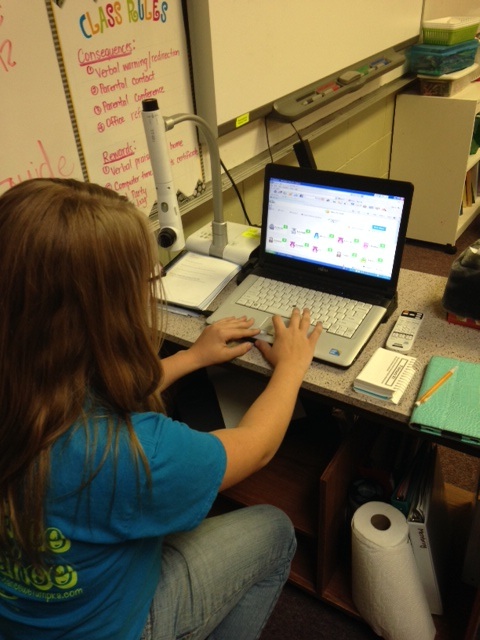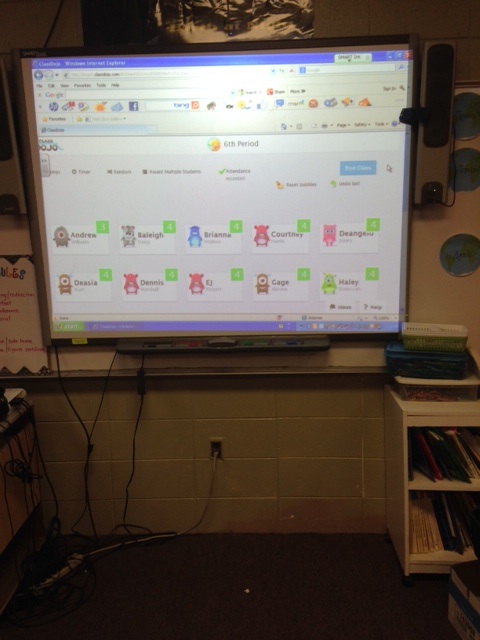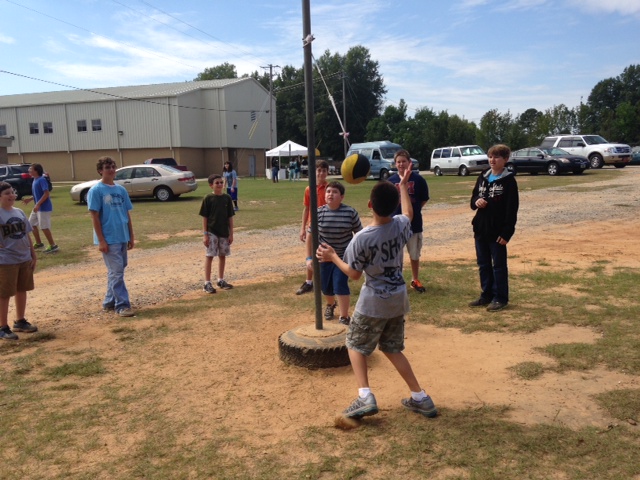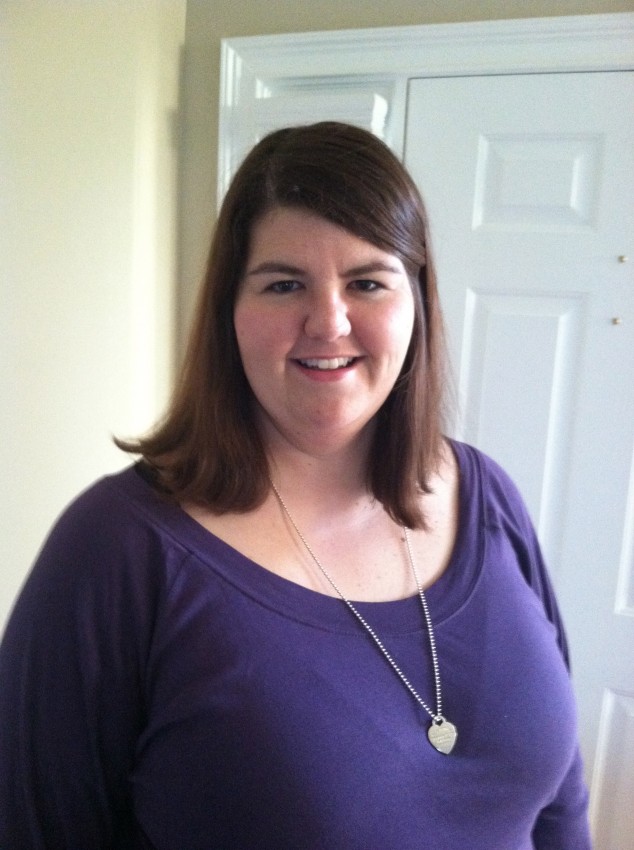
Class Dojo is a popular and somewhat controversial free tech tool for behavior management. I frequently hear it recommended by teachers at all grade levels, but am not familiar with it personally. So, I’ve invited a teacher who has used Class Dojo with her students to explain what’s worked for her. Amanda Killough, who has been teaching middle school Social Studies for eleven years, is here to share with us how Class Dojo helps reinforces positive behavior in both her individual students and the class as a whole. Thank you, Amanda!
Teaching middle school is not for the faint of heart. Often, when I tell people what grade I teach, I get the look of sympathy and a good old-fashioned “Bless your heart!” I, however, love the middle grades and all the challenges that come along with them. Managing middle school kids is sometimes like herding cats, but Class Dojo is a great tool to make it easier.
I have been using Dojo in my classroom for two years and absolutely adore it! Dojo is a free (!) online tool that allows teachers to set up classes and keep track of positive and negative behaviors in class. When I first learned about Dojo, I was not sure if it my students would find it too babyish or silly. I had nothing to worry about- middle school students LOVE Dojo!!
Class Dojo is easy to set-up and use (which is always a plus). Simply create an account using your school email and you are ready to go. Once you are into Dojo, you can choose icons for each class and begin setting up your classes. The program automatically assigns fun avatars for each student, but you can change them. Next, you can use the pre-set positive and negative behaviors or personalize them. Very quick and easy!

Now that you are set-up, the fun begins! I display Dojo on my SMART board and each week I have a Dojo assistant for each class that assists me with getting the class started. That student is chosen based on their previous week’s Dojo points (more on that later). To begin a class in Dojo, you must take attendance first and then the class is ready to earn points. I allow my assistant to take attendance in Dojo while I am getting the class started on their bell ringer.
One of the great things about Dojo is that it allows you to award points to individual students or the entire class. If all students come in and are working on their bell ringer, I have my student Dojo assistant award the entire class a point for being on task. This lets them know I have recognized they are following class procedures. When you award a point, Dojo makes a happy sound and gets the student’s attention. If several students are off task, I do not award the entire class a point. You would be surprised how this one little point has students encouraging each other to come in and get started on their assignment.
After attendance and the initial awarding of points, I take over the Dojo duties. I can keep Dojo minimized and continue on with my lesson for the day. Keeping it minimized gives me instant access if I need to award or take away a point.

In my classroom, I try to use Dojo to focus on positive behaviors instead of the negative ones. For example if a student is off task, I try to award the students around him for being on task. It is my hope that by not specifically “calling him out,” he will recognize that he is not on task. This works most of the time. Of course, if that tactic does not work, I do take away points. Dojo also makes a sad sound when points are loss and this almost immediately catches students’ attention.
Additionally, there is a Dojo app for your tablet or phone. This allows you to award points in the hallways, lunchroom, and other special events.
Another great (maybe?!) thing about Dojo is that parents can have insight into their child’s behavior during the day. All I have to do is input parent emails into Dojo, print out an access code, and they can see all their child’s information. On Fridays, Dojo can be set up to automatically send an email with all the positive and negative points received for the week. Additionally, parents can login whenever they want to check the progress. One of my colleagues has a parent who checks their account hourly and offers incentives at home for reaching a set amount of points!
To keep Dojo relevant to my students, I offer free and intangible rewards. First thing Monday morning, I always award my Dojo prizes. Students with 15 or more points can sit next to a friend in the class or at lunch. This is great because I have assigned seats. Students in this category also have the opportunity to be Dojo assistant for the week. Students with 10-14 points get computer time to play games. Students with 5-9 points get a school “gotcha ticket” that goes into a weekly drawing. The first time a student earn 5-9 points, I allow them to change their avatar to one of their choosing. These are all simple and free rewards that the students love. The little things really do motivate them to exhibit positive behavior!
I also have consequences for those who end up with negative points at the end of the week. These students have to sign the discipline log. Signing the discipline log multiple times leads to parental phones calls/conferences and eventually referrals to administration. At the end of the month, students have not signed the discipline log get to attend the pod party in which our entire pod goes outside and plays for a couple of hours.

Dojo has a lot of great uses in the classroom and it is easy for teachers and students to become addicted! However, we must remember Dojo is free and there are sometimes technical issues. Some days Dojo isn’t the fastest, doesn’t load, or the music doesn’t work, but that isn’t very often. Dojo is a fantastic tool for elementary and early middle school, but I am not sure how well it works at the high school level. I teach 7th grade and sometimes their “I don’t care” attitudes make negative Dojo points less effective.
ClassDojo is another great tool to add to your toolbox to help manage behavior. It has helped me to recognize positive behaviors instead of always focusing on the negative ones. I have also found that it encourages teamwork and self-regulation among my students.
Amanda Killough has been teaching middle school Social Studies for eleven years. She always envisioned herself as a high school teacher, but believes her true calling is with middle school students. Most of the time, she’s found that teaching middle school is more about life lessons than book lessons. She has a B.A. in History from the University of Montevallo, M.Ed. from Auburn University Montgomery in Secondary Education, and an Ed.S in Teacher Leadership from the University of West Alabama. Amanda and her husband have a one-year-old daughter and love the roller coaster called parenthood!

What’s your take on Class Dojo? Please share your opinions, questions, and experiences in the comments. And if you’d like to have your own classroom management strategy or story featured here, just fill out the guest blog form!

Angela Watson
Founder and Writer
Sign up to get new Truth for Teachers articles in your inbox
Discussion
OR

Join our
community
of educators
If you are a teacher who is interested in contributing to the Truth for Teachers website, please click here for more information.
















I’m using Dojo this year and 99% of the points I give are positive, for Showing Respect, Being On Task, Caring for the Classroom, Whole Body Listening, etc. It’s the second week and I haven’t had any complaints from students or parents. My students always get a warning before any negative points are awarded for behavior. They get one bathroom freebie a day and then, yes, I do take points away for that… we have multiple breaks during the day and I have always had groups of students who go to use the bathroom just to be able to leave class. I’d also kind of like parents to know that their students are using the bathroom five times a day… if it’s legit, there might be a medical reason! I never tell a student flat ‘no;’ I say in a neutral voice something like, “Okay, but you’re going to lose a point, and we have recess in 10 minutes.” It’s amazing how many students are suddenly able to wait! Oh, and I don’t display points — it’s no one else’s business how many points they have — and only share them with students before or after school. Oh, and the new messenger function is pretty nice too, a great way to communicate with parents or answer their questions after hours without giving out my cell number.
TL;DR – like any management tool, you have to use it thoughtfully. It’s working for me.
I appreciate all the great thoughtful educator comments in suggesting parents actually talk with their child’s teacher about their concerns. My 5.5 yr old just started K and they are implementing this, so my googling led me here. Any program that takes points away seems anti-self-esteem to me, which is why I looked up others’ responses. I wonder if it is discriminatory in nature and tends to be harder for minority and immigrant students and students who have learning difficulties (or small bladders?) or from lower socio-economic circumstances like many of these other types of programs.
As a teacher myself, when we used marbles towards class rewards years ago, you were never to take marbles out of the jar- just add them appropriately and deal with negative behavior in a more quiet way.
Also, If the program is free, who sponsors it and why and who is providing the training to teachers to use it in the classroom?
My kiddo’s teachers are awesome, so I’m not so concerned since they are loving and experienced, but I’d like to see how my daughter reacts the first time she gets negative points- I hope it’s nothing like I felt the first time I had to stand against the wall during lunch for talking during quiet time in elementary school in the late 70’s. Nothing like everyone knowing you blew it when you are generally never in trouble. True, not everyone gets a cookie every time, so to speak, but no child should ever have negative points in school for any reason, in my opinion.
My daughter was thrilled to get to go to the treasure box in week 1 for great behavior, but she also did a year of pre-K and is good at the game of school (one of 2 in class of 23 who got to go, I believe, but could be wrong).
Some of her classmates are not quite so adept at school yet, and I hate to see their ADHD and/or a lack of schooling prevent little Kindergarteners from getting little rewards, esp when they have so little school experience, similar to the child referred to in previous emails who was homeschooled. And way to go to that parent for talking with their kid’s teacher. I think I need to do the same- if not for my kid, then to look out for others’ children who are apt to end up with negative points by Monday afternoon… high class problems but worth it to address ‘fore the therapy bills pile up!
Exactly, for me, I see this just like the marbles method–you add to the jar, but you shouldn’t take any away except in very extreme (preferably pre-determined) circumstances. The marble or dojo point represents a good choice. A poor choice later on does not negate the first choice. And what happens when you get down to negative points or all the marbles are gone?
I agree! I commented a few times already on this and have spoken to the teacher weeks ago and thought it would get better. But now I am getting phone calls from the principal and teacher because my son is throwing things and getting frustrated. They put him on the phone and he tells me he hates school because these points are frustrating him. On Friday he got 9 negative points in less than 2 minutes for the same thing (not following directions)!!! Seems to me they didn’t even give him a chance to stop what he was doing and the point after point probably fueled his frustration! He comes home with sad faces on his calendar instead of a terrific stamp on some days and asks me if I am still proud of him even though he got bad points. A 5 yr old should not be focusing on the points more than learning but he is. Something that is supposed to help kids learn right from wrong is turning my son into a different kid then he was 2 months ago before school started and making him act out more, reversing everything I did the last 5 years. :/
My 5 year old doesn’t want to go to school anymore. He was getting good dojo points but now he has deteriorated to the point of I think he needs to be looked at for special needs class. He’s only 5 years old, but at my work of you were only 30% productive for the day you are walked out the door. From 75% – 80% to 30% percent days in less than 2 months is horrific to me and his father.
I agree! My 5 yr old started at 100% the first day of school, next week 80%, next week 60%, next week 54%, next week 50%, this week so far 44%….he comes home wanting to see his points every day at home and the look of disappointment and frustration on his face should NEVER be on a 5 yr olds face! Most of the time he tells me he didn’t even do what they gave him a negative point for or he gets 5 negatives in 1 minute time for the same thing! Nothing good is coming out of this system except making children hate school. UNLESS they focus on positives more than negative which some teacher do and thank god for them, just wish my sons teacher was one of them.
Hi Angela,
I teach French to about 100 students a day. I have four different classes.
I am really debating if I should begin CD with my classes and would like some guidance. I am thankful for all of the comments made by parents and teachers about how the Dojo system affects their kids. I guess if I were to use it, it would be to only recognize positive behaviors. I think I’d also keep my current management system of giving verbal reminders to students demonstrating off-task behaviors and if needed, pull the student aside to discuss the appropriate consequences-but that would be in private. I wouldn’t display the points awarded to students because I feel that this information is private.
That being said, from a practical point of view, how much time will it take away from my teaching to award points on my iPad? I imagine quite a bit, if there are 30 kids in the class. I wouldn’t want to have the sound on either, as I think that would distract my students. Another thing is that how much time is it going to take to let students know about the points they receive for each period? Would they need to log-on at home for the updates?
I teach in a community where I know that I will questioned quite regularly for points not awarded.
I am not planning on sending hourly reports about student performance, either. It just seems to me that this system can get complicated.
Now that I have listed my concerns and questions, it seems like an obvious decision for me.
I just worry about equity and building up a child’s self-esteem and not the opposite.
I’d greatly appreciate any comments about what I’ve written in this post. Thank you.)
I use it in middle school English and each period is a “student” in my dojo class. I use it for each period as a team gaining and losing points together. Each period competes against the others for a small prize at the end of each grading period. I display points at all times and I don’t email parents reports. I make note of individual problems and call those parents. So far so good!
I like your idea of just awarding positive points. I wouldn’t think that awarding points would take away from class time but actually add to it, just like telling kids “good job!” The positive recognition refocuses and motivates kids, and gets them back on task. At least, that’s what I tend to experience. If I stop to recognize one child, all the others scramble to get on task, too!
Don’t throw the baby out with the bathwater! Dojo is a great system if used properly but like any system, it’s only as good as the operator. Instead of whinging about the system here, speak to the teacher as soon as you have an issue with it. Simple!
If you actually read the comments you would see that is what everyone has already done or has recommended to others….in a little nicer way.
Wish it was that simple. The principal likes it, so the tool stays. I do plan to address issues with the principal. Going to the top will save time and we can get answers quickly.